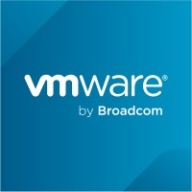

IBM PowerVM and VMware vSphere are major competitors in the virtualization software industry. While both offer robust feature sets, IBM PowerVM has a slight edge due to its resource optimization and high availability, although VMware vSphere stands out with comprehensive management and flexibility.
Features: IBM PowerVM is known for optimizing resources, high security, and top-notch availability. It stands out for handling large workloads reliably and with stability. VMware vSphere is recognized for centralized management and flexibility, along with advanced features such as vMotion and high availability, making its virtualization capabilities widely praised.
Room for Improvement: IBM PowerVM could enhance its cloud integration, pricing structure, and graphical user interface for easier management. Users express concerns over costs and request more transparency. VMware vSphere could improve its complex licensing process, streamline its GUI, and work on reducing costs. Users suggest better clarity in fault tolerance features and some interface improvements.
Ease of Deployment and Customer Service: IBM PowerVM is preferred for on-premises deployments and is rated highly for its proactive technical support, with users praising IBM's quick response and in-depth support. VMware vSphere is versatile across on-premises, hybrid, and cloud environments, with technical support described as satisfactory but not exceptional in all regions.
Pricing and ROI: IBM PowerVM carries a higher cost, but users see value due to its features without extra licensing fees, making the ROI beneficial, especially with large database systems. VMware vSphere is considered more expensive with intricate licensing models. Users recognize the high cost but acknowledge the range of features and reliability that justify the investment in large enterprise settings.
The return on investment is substantial, though other platforms may offer a better ROI, primarily due to lower costs involved in setup and maintenance.
If calculated over a five-year period, IBM PowerVM is 30 to 40% more cost-effective than physical servers despite initial costs seeming high.
We can say 10% is the approximate amount of savings because most of the things are automated and streamlined, so the manual work is eliminated in most cases.
IBM provides strong support.
IBM offers excellent customer support.
IBM's technical support is outstanding, with seamless global coordination and prompt resolutions.
Priority one issues are usually addressed by engineers within one to two hours.
Recently, support has been less friendly and slower, especially after the company was acquired by Broadcom.
If we have issues, the support tends to be unreliable
An IBM server can handle up to sixty-four terabytes of RAM.
The product is scalable due to PowerVM's virtualization features, such as shared processor functionality and partition mobility.
I think IBM PowerVM uses a 'pay as you grow' model, allowing customers to scale their resources as needed.
Scaling is easy, whether it is hyperconverged or a three-tier architecture.
VMware vSphere is highly scalable in terms of the number of users and the number of servers it can handle.
It is a highly scalable solution.
The stability of IBM PowerVM is exceptional, as industry reports have named IBM Power and Z as the most stable platforms globally for 15 consecutive years.
Our clients in India using Power Servers have been running their servers for the last four to five years without any reboot.
The product operates reliably, and following IBM’s best practices ensures robust stability.
It is a very stable hypervisor solution.
While they are generally stable, if outages occur, they tend to be due to brands like HP or Dell, not VMware vSphere itself.
Mostly we don't have issues, but sometimes we have faced some stability issues because of some bugs and some CPU compatibility issues with Intel CPUs.
We have a strong relationship with IBM, which aids decision-making in transitioning clients from mainframe to other platforms.
PowerVM should integrate some capabilities of VMware vCenter to improve its management features.
From a product perspective, I would like to see faster certification of open-source products on IBM Power Systems.
The cost changed from perpetual to subscription, and there is a need for alternative solutions.
Another area is the stability during upgrades from older versions to newer versions, where we face issues.
Sometimes, it is difficult to find documentation for specific tools and solutions.
Pricing is a concern in Argentina due to the higher cost of mainframe solutions.
PowerVM itself is free with the purchase of an IBM server.
While initially costly, the ROI over five years proves IBM PowerVM is cost-effective, resulting in a 30 to 40% reduction in costs compared to a physical setup.
Many customers are trying to avoid it due to its high cost.
Costs significantly increased from perpetual to subscription, with prices rising by two to three times over three to five years.
The solution is too expensive.
Features like partition mobility enhance the machine's capabilities, making it an ideal tool for virtual environments with reliability, availability, and serviceability.
PowerVM excels in efficiently managing all systems and environments, including development, UI, and production.
It supports specific workloads, like Oracle and SAP HANA, much better due to its shared processor pool feature which reduces licensing costs.
The vMotion feature is beneficial for online migration of virtual machines from one host to another without downtime.
The tool is highly available, which is crucial for implementing critical applications requiring 24/7 availability.
I always use VMware vSphere vMotion; we work with this feature all the time. vMotion is very useful; that's why we use the virtualization.
| Product | Market Share (%) |
|---|---|
| VMware vSphere | 16.8% |
| IBM PowerVM | 1.3% |
| Other | 81.9% |


| Company Size | Count |
|---|---|
| Small Business | 13 |
| Midsize Enterprise | 5 |
| Large Enterprise | 20 |
| Company Size | Count |
|---|---|
| Small Business | 174 |
| Midsize Enterprise | 137 |
| Large Enterprise | 256 |
VMware vSphere is a versatile virtualization platform known for its ease of use, flexibility, and high availability. It supports seamless migration, optimal resource allocation, and centralized management, making it highly suitable for diverse infrastructure needs.
VMware vSphere is widely adopted for its virtualization capabilities that enhance hardware efficiency and ensure minimal downtime through features like High Availability and Distributed Resource Scheduler. Despite criticisms about high licensing costs and limited fault tolerance, it remains a preferred choice due to its stability, scalability, and robust integration options. Users appreciate its efficiency in managing virtual machines and hosting enterprise applications, although challenges with web client performance and hardware compatibility are noted. Organizations often look for better integration with cloud services and enhanced automation and scalability.
What are the core features of VMware vSphere?
What benefits and ROI can businesses look for?
VMware vSphere is implemented across sectors like healthcare, finance, and education for server virtualization, data center management, and private cloud creation. Its use in facilitating business-critical operations ensures high availability and efficient resource use, supporting both development and production environments.
We monitor all Server Virtualization Software reviews to prevent fraudulent reviews and keep review quality high. We do not post reviews by company employees or direct competitors. We validate each review for authenticity via cross-reference with LinkedIn, and personal follow-up with the reviewer when necessary.